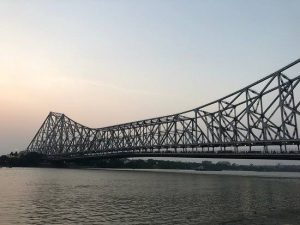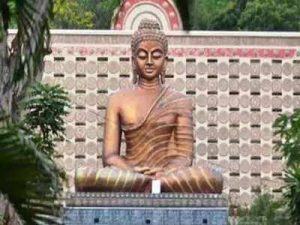Table of Contents
Daily Current Affairs for Government Exams:
Today Current Affairs: 13th January 2020 for UPSC IAS exams, State PSC exams, SSC CGL, State SSC, RRB, Railways, Banking Exam & IBPS, etc.
Contents:
- First successful landing on the aircraft carrier INS Vikramaditya.
- Kolkata Port Trust in Kolkata.
- Artemis program.
- Citizen’s right to own private property is a human right.
- Levels and Trends in Child Mortality report.
- H9N2.
- National Youth Day 2019.
- Second Tallest Statue of Gautam Buddha.
- Coastal Regulation Zone.
- PROTECTION OF CULTURAL PROPERTY IN ARMED CONFLICT.
- Other important current affairs
1. First successful landing on the aircraft carrier INS Vikramaditya:

The naval version of indigenous Light Combat Aircraft (LCA) Tejas, made its first successful landing on the aircraft carrier INS Vikramaditya.
About:
- After completing extensive trials on the Shore Based Test Facility, LCA Navy did an arrested landing on INS Vikramaditya.
- LCA Navy is developed by the Defence Research and Development Organization, DRDO.
- With the successful landing of Light Combat Aircraft, LCA on aircraft carrier INS Vikramaditya, India has entered into the club of selected nations having the capability to design a fighter jet that can land on an aircraft carrier.
- LCA is the smallest and lightest Multi-Role Supersonic Fighter Aircraft of its class.
- The LCA program intends to further expand and advance India’s indigenous aerospace capabilities.
2. Kolkata Port Trust in Kolkata:

Prime Minister Narendra Modi attended the 150th-anniversary celebration of Kolkata Port Trust in Kolkata.
- Commemorative stamps released on the 150th celebrations of Kolkata Port Trust.
- He announced to rename the Kolkata Port Trust after Bharatiya Jana Sangh founder Shyama Prasad Mukherjee.
About:
- The Port of Kolkata is a riverine port in the city of Kolkata, India, located around 203 kilometers from the sea.
- It is the oldest operating port in India and was constructed by the British East India Company.
- It Opened in 1870 and is operated by Kolkata Port Trust.
- The Port has two distinct dock systems – Kolkata Docks at Kolkata and a deep water dock at Haldia Dock Complex, Haldia.
Prime Minister Narendra Modi launched the Interactive Light & Sound Show of Rabindra Setu (Howrah Bridge) in Kolkata.

About:
- Howrah Bridge is a bridge with a suspended span over the Hooghly River in West Bengal, India.
- It was commissioned in 1943.
- In 1965, it was renamed Rabindra Setu after the great Bengali poet Rabindranath Tagore, who was the first Indian and Asian Nobel laureate.
- It is an engineering marvel as it does not have nuts and bolts, but was formed by riveting the whole structure.
- The Howrah Bridge is currently the sixth-longest cantilever bridge of its type in the world.
3. Artemis program:
NASA announces a graduating class of 11 astronauts for upcoming space missions including the Artemis Mission. The team includes an Indian American- Raja Chari.
About:
- NASA wants to send the first woman and the next man to the Moon by the year 2024, which it plans on doing through the Artemis lunar exploration program.
- With the Artemis program, NASA wishes to demonstrate new technologies, capabilities and business approaches that will ultimately be needed for the future exploration of Mars.
- For the Artemis program, NASA’s new rocket called the Space Launch System (SLS) will send astronauts aboard the Orion spacecraft a quarter of a million miles away from Earth to the lunar orbit.
- Once astronauts dock Orion at the Gateway — which is a small spaceship in orbit around the moon — the astronauts will be able to live and work around the Moon, and from the spaceship, astronauts will take expeditions to the surface of the Moon.
- The astronauts going for the Artemis program will wear newly designed spacesuits, called Exploration Extravehicular Mobility Unit, or Xemu.
4. Citizen’s right to own private property is a human right:
The Supreme Court has recently held that a citizen’s right to own private property is a human right.
- The case was of an 80-year-old woman whose 3.34-hectare land was forcibly taken by the Himachal Pradesh Government in 1967, for constructing a road.
- The Court used its extraordinary jurisdiction under Article 136 and Article 142 of the Constitution to direct the government to pay the woman compensation of 1 crore rupees.
- A citizen’s right to own private property is a human right. The state cannot take possession of it without following due procedure and authority of law.
- The Bench referred to an earlier verdict in State of Haryana v. Mukesh Kumar case (2011) wherein it was held that the right to property is not only a constitutional or statutory right but also a human right.
- The doctrine of Adverse Possession: The state cannot trespass into the private property of a citizen and then claim ownership of the land in the name of ‘adverse possession. Grabbing private land and then claiming it as its own makes the state an encroacher.
5. ‘Levels and Trends in Child Mortality’ report:
Recently, the United Nations Children’s Fund (UNICEF) released the ‘Levels and Trends in Child Mortality’ report. According to it, unlike global trends, India’s under-5 mortality of girls exceeded that of boys in 2018.
- On average, boys are expected to have a higher probability of dying before reaching age-5 than girls (for the world)
- The global report states that fewer countries showed gender disparities in child mortality in 2018.
Key Points:
- Countries primarily located in Southern Asia and Western Asia have a significantly higher risk of girls dying before age 5.
- According to the report, half of all under-5 deaths in 2018 occurred in five countries: India, Nigeria, Pakistan, the Democratic Republic of the Congo and Ethiopia.
- India and Nigeria alone account for about a third.
- Despite the tremendous progress in child survival made over the past two decades, one child or young adolescent died every five seconds in 2018.
- The burden of child mortality is determined both by the mortality rate (the proportion of children who die) and by the estimated population of any given State (total number of annual births).
- Current trends predict that close to 10 million 5 to 14-year-olds and 52 million children under 5 years of age, will die between 2019 and 2030. Almost half of these under-5 deaths will be newborns.
Indian Context:
- The majority of child mortality cases in India are attributable to deaths during the neonatal period.
- The major causes of neonatal mortality are preterm birth, intrapartum related events, and neonatal infection.
- In the post-neonatal period, the major direct causes of death are diarrhea and pneumonia.
- India’s neonatal mortality rate is 23 per 1,000 live births.
- According to India’s 2017 Sample Registration System (SRS), the States with the highest burden of neonatal mortality are Madhya Pradesh, Odisha, and Uttar Pradesh, with 32, 33 and 30 neonatal deaths per 1,000 live births, respectively.
- Jharkhand, Bihar, and Uttarakhand showed the largest gender gaps in under-5 mortality.
- Uttar Pradesh is the state with the highest number of estimated newborn deaths in India, both because of the high neonatal mortality rate and because of the large number of births that occur every year in the State.
6. H9N2:
Indian scientists of the National Institute of Virology (NIV), Pune have detected the country’s first case of infection with avian influenza A(H9N2).
About:
- H9N2 is a subtype of the influenza A virus, which causes human influenza as well as bird flu.
- The H9N2 subtype was isolated for the first time in Wisconsin, the US in 1966 from turkey flocks.
- H9N2 viruses are found worldwide in wild birds and are endemic in poultry in many areas.
- H9N2 virus infections in humans are rare, but likely under-reported due to typically mild symptoms of the infections.
7. National Youth Day 2019:

National Youth Day (NYD) is observed on Swami Vivekananda’s birth anniversary on January 12 every year.
- To honor Swami Vivekananda’s contributions to the country, the government in the year 1984, declared his birthday as National Youth Day.
- The main objective of NYD is to promote rational thinking among the youth. Youth is expected to rise to the values, principles, and beliefs that Vivekananda lived by.
- National Youth Festival (NYF) 2020: On this occasion, the Ministry of Youth Affairs and Sports and Uttar Pradesh government also jointly organized 23rd NYF 2020.
- The Government has been organizing National Youth Festival (NYF) since 1995.
- The objective of NYF is to provide an arena where youth can interact and exchange their social and cultural uniqueness. This blend of diverse socio-cultural milieu proves belief in ‘Ek Bharat Shrestha Bharat’.
- The theme of the NYF 2020 is ‘FIT YOUTH FIT INDIA’.
Swami Vivekananda (1863-1902):
- He was born as Narendranath Datta on January 12, 1863.
- Introduced the world to the Indian philosophies of Vedanta and Yoga.
- He was the chief disciple of the 19th-century mystic Ramakrishna Paramhansa.
- Laid the greatest emphasis on education for the regeneration of our motherland. He advocated a man-making character-building education.
- Established the Ramakrishna Mission in 1897. It is an organization that works in the area of value-based education, culture, health, women’s empowerment, youth, and tribal welfare and relief and rehabilitation.
- He died at Belur Math in 1902. Belur Math, located in West Bengal, is the headquarters of Ramakrishna Math & Ramakrishna Mission.
8. Second Tallest Statue of Gautam Buddha:

The world’s second tallest statue of Gautam Buddha is proposed to be built in Dev Ni Mori, Sabarkantha district, Gujarat.
- The proposed statue (108m) would be second in the world after the Spring Temple in China (153 meters).The relevance of Dev Ni Mori
- Dev Ni Mori was excavated by the state archaeology department in 1953.
- The remains of a Buddhist monastery belonging to the 3rd-4th century AD have been unearthed from Devni Mori.
- The most important discovery from the site, however, was a 1,700-year-old casket that has bodily relics of Buddha.
- The inscription clearly mentions that the casket contains bodily relics of Buddha.
9. Coastal Regulation Zone:
The four illegal apartment complexes in Maradu, Kerala, was razed by controlled implosion on the orders of the Supreme Court for breaching Coastal Regulation Zone (CRZ) norms. The court had called the illegal constructions a “colossal loss” to the environment.
- The villas are constructed in the Vembanad backwaters — a Ramsar site. The wetland is of international importance and protected by the Ramsar Convention.
What are the CRZ norms?
- In India, the Coastal Regulation Zone (CRZ) Rules govern human and industrial activity close to the coastline, in order to protect the fragile ecosystems near the sea. They restrict certain kinds of activities — like large constructions, setting up new industries, storage or disposal of hazardous material, mining, reclamation and bunding — within a certain distance from the coastline.
Background:
- After the passing of the Environment Protection Act in 1986, CRZ Rules were first framed in 1991.
- After these were found to be restrictive, the Centre notified new Rules in 2011, which also included exemptions for the construction of the Navi Mumbai airport and for projects of the Department of Atomic Energy.
- In 2018, fresh Rules were issued, which aimed to remove certain restrictions on building, streamlined the clearance process, and aimed to encourage tourism in coastal areas.
- In all Rules, the regulation zone has been defined as the area up to 500 m from the high-tide line.
Restrictions?
- The restrictions depend on criteria such as the population of the area, the ecological sensitivity, the distance from the shore, and whether the area had been designated as a natural park or wildlife zone.
- The latest Rules have a no-development zone of 20 m for all islands close to the mainland coast, and for all backwater islands in the mainland.
9. Protection Of Cultural Property In Armed Conflict:
President Donald Trump tweeted that if Iran strikes any Americans, or American assets, in retaliation, the US would target 52 sites in Iran which are important to Iranian culture. Such a step, should he follow through on his threat, could be considered a war crime.
About:
- The nations of the world adopted at The Hague in 1954, The Convention for the Protection of Cultural Property in the Event of Armed Conflict, the first international treaty focussed exclusively on the protection of cultural heritage during the war and armed conflict.
- The Convention defined cultural property as “movable or immovable property of great importance to the cultural heritage of every people, such as monuments of architecture, art or history, whether religious or secular; archaeological sites.
- The Rome Statute of 1998, the founding treaty of the International Criminal Court, describes as a “war crime” any intentional attack against a historical monument, or a building dedicated to religion, education, art, or science.
Other important current affairs:
1. SEA GUARDIANS: The sixth bilateral naval exercise between China and Pakistan, code-named Sea Guardians-2020 was recently held in the northern Arabian Sea, with the purpose of enhancing security cooperation between the two countries.
2. Samsung’s Star Labs has officially unveiled Neon as its latest artificial intelligence (AI) powered project. Neons are Artificial Intelligence virtual beings capable of showing human-like emotions and intelligence.
3. Breaking the tradition of consensus-based decisions in its 37 earlier meetings, the GST Council voted for the first time in its 38th meeting held in December 2019. The proposal to have a higher single rate for lotteries went through by a majority, with 21 votes in favor.
4. An international team of researchers has reported that they have sequenced the genome of the Indian cobra, in the process of identifying the genes that define its venom. This, they hope, can provide a blueprint for developing a more effective antivenom.
5. The population of Mugger Crocodile is on the rise in Odisha’s Ghodahada reservoir.
- As per the annual crocodile census conducted in the Ghodahada reservoir, the number of mature mugger crocodiles in the Ghodahada reservoir and its adjoining area has increased.
- The reservoir is located close to the Lakhari Valley Sanctuary and is a part of the Eastern Ghats.
- The reservoir is fed by Ghodahada river which is a tributary of the Rushikulya.
6. Australia recorded 2019 as its hottest year on record. Around 1.25 billion animals are believed to be dead in bush fires. It has also destroyed more than 10 million hectares of land.
- The Australian Koalas are to be put under “endangered” from “vulnerable” as 30% of their habitat were destroyed by the fires.
- The Australian Government has announced 50 million Australian Dollars emergency funds to save the wildlife affected due to the fires.
7. The NIIT (National Institute of Information Technology), a multi-national company has been selected as one of the EdTech companies for the NEAT initiative.
- The NIIT will work with AICTE to implement the vision of the Ministry of HRD (Human and Resource Development) on NEAT.
- The National Educational Alliance for Technology (NEAT) was launched to customize the learning process using Artificial Intelligence.
8. A new Trojan called Shopper malware is increasing its presence among smartphone users. The malware is screening unsolicited ads and flashing fake reviews.
9. On January 13, 2020, the World Future Energy Summit is to begin at Abu Dhabi. It is to be held for four days.
- The Summit will have 33,500 participants from 170 countries. It will also include 800 special exhibits.
- The event is to be conducted under the theme: Rethinking Global Consumption, Production, and Investment
- Along the summit, the CLIX-Climate Innovations Exchange will also be held.
10. The Government of India will acquire around 200 aircraft. Of these 200, 83 fighter jets are LCA Tejas Mark 1A and are to be procured from HAL. The rest are to be procured based on Request for Proposals.
11. The 18th Dhaka International Film Festival was inaugurated in Dhaka, Bangladesh by the Foreign Minister of Bangladesh Dr. A.K. Abdul Momen.
12. Amit Shah launches the country’s first Cyber Crime Prevention Unit ‘AASHVAST’ in Gandhinagar
- Union Home Minister Amit Shah has inaugurated the country’s first Cyber Crime Prevention Unit AASHVAST in Gandhinagar, Gujarat.
- He also launched Video Integration and StateWide Advance Security-VISHWAS project.
13. Bipul Behari Saha, a noted chemist has been elected as a bureau member (2020-23) of the International Union of Pure and Applied Chemistry (IUPAC). for the period 2020-23.
14. Lt Col Yuvraj Malik has been appointed the Director of the National Book Trust (NBT) on deputation from the Indian Army.
15. Indian pacer Jasprit Bumrah (world’s No. 1 ODI bowler) will receive the Board of Control for Cricket in India (BCCI)’s Polly Umrigar Award for his super performance in international cricket in the 2018-19 season.




